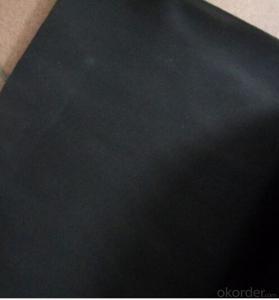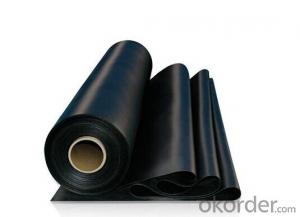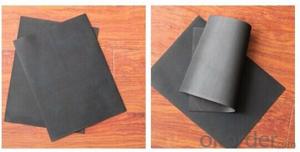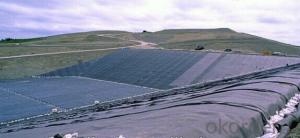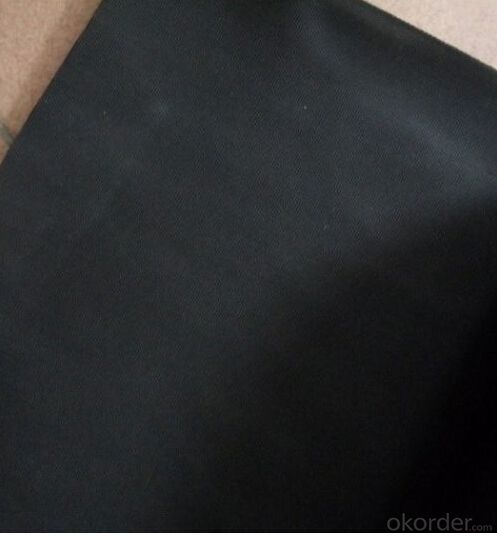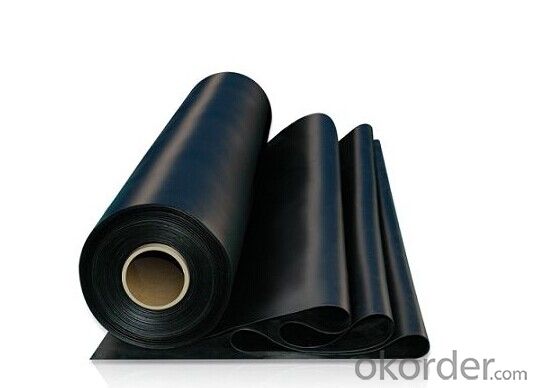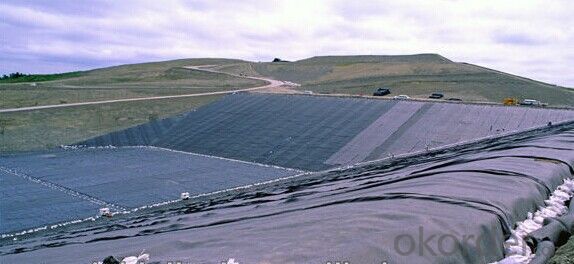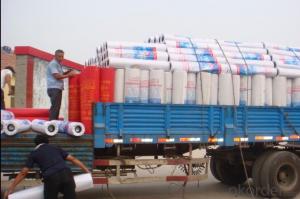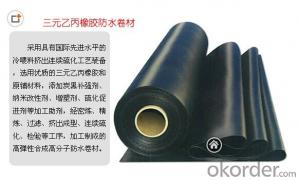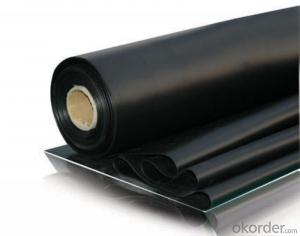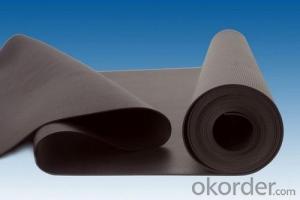Black EPDM Waterproofing Membrane Factory Price
- Loading Port:
- Qingdao
- Payment Terms:
- TT OR LC
- Min Order Qty:
- 2000 m²
- Supply Capability:
- 100000 m²/month
OKorder Service Pledge
OKorder Financial Service
You Might Also Like
Product Description
This waterproof coiled material is of high elasticity with best performance among high polumer
waterproof coiled material in the world.It is also the most typical one in the world.Waterproof coiled material made of ternary ethylene-propylene rubber is produced withthe use of the most advanced contiuous extrusion and vulcanization technology and related equipments which are specially designed for production of such product.It is good in compactness,without bubble and performance difference in length and breadth,perfomances reach or exceedthe demands of GB18173.1-2000 standard.
Features
Excellent antiaging performance, service life up to 50 years
Working well with in 40C to 100C,it canbe constructed with a single layer in ambient temperature.
Waterproofing on various kinds of underground project,industrial of civil buildings and structures.
high extension rate, high tensile strength, small size changes at heat treatment
Good plant roots penetrability resistance and can be made waterproofing layer of planting roof
Special modified molecular structure ,effectively resolving the current domestic and foreign glue joint problem .
Good low temperature flexibility, and good performance of adapting to ambient temperature changes.
Convenient application ,solid joint, no environment pollution
chemical corrosion Resistance, can be used for special occasions
Convenient maitenance, low cost.
Specifications
Type | EPDM Waterproof Membrane | ||
Material | EPDM Rubber | ||
Thickness | 1.2mm | 1.5mm | 2.0mm |
Weight(kg/m2) | 1.54-1.58 | 1.79-1.83 | 2.25-2.29 |
Size | 1.2m(width) * 20m(length)/roll | ||
Type | Vulcanized & Weldable | ||
Pattern | Non-reinforced(homogeneous) | ||
Packing | 24sqm/roll, with plastic bag | ||
Color | Black | ||
Application | Roof, basement, pond, Lake, steel structure roof, swimming pool, underground, tunnel, etc | ||
Application
(1) Roofs, Basement, Toilets
(2) Industrial and civil building waterproofing
(3) Geosynthetic liner for swimming pool, channels, irrigation system
(4) Especially suitable for projects with high requirements in durability, anti-corrosion and deformation
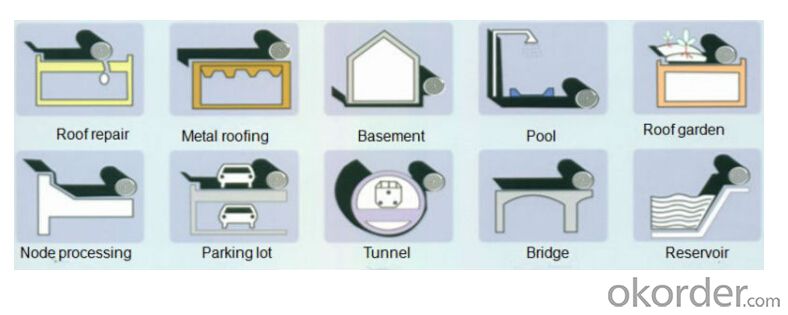
4. Some photos:
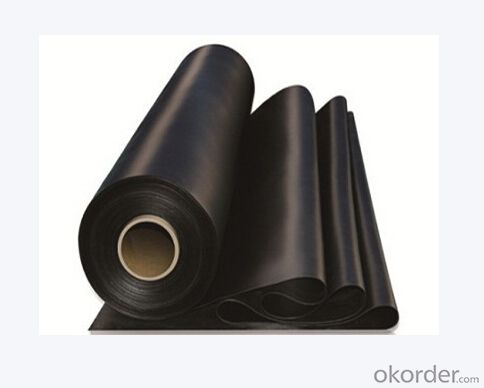
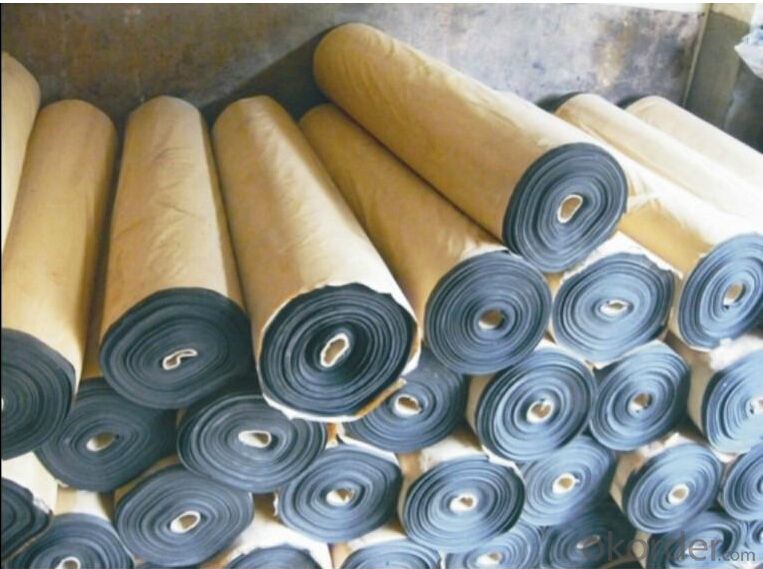
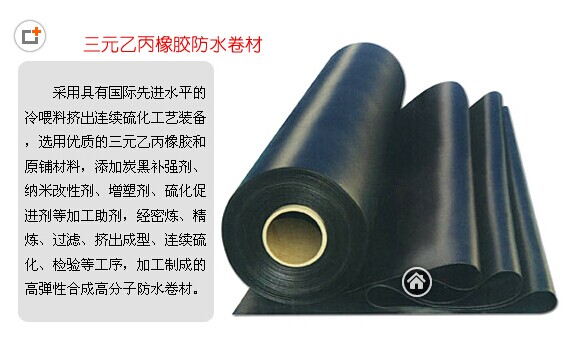
- Q: Can a waterproofing membrane be used for bathrooms or showers?
- Bathrooms or showers can benefit greatly from the use of a waterproofing membrane. It is highly advisable to apply this protective layer in order to avoid any water leaks or harm to the underlying structure. Typically, the membrane is spread across the walls and floor of the bathroom or shower area, creating a barrier that stops water from penetrating through. This safeguard not only shields the surrounding areas from moisture, but it also prevents the growth of mold and mildew. Moreover, a waterproofing membrane is instrumental in extending the lifespan of the bathroom or shower by preventing water damage and deterioration. All in all, employing a waterproofing membrane is an efficient solution to ensure the resilience and longevity of these spaces.
- Q: Can a waterproofing membrane be used in fountains or water features?
- Yes, a waterproofing membrane can be used in fountains or water features. Waterproofing membranes are designed to protect surfaces from water penetration and are commonly used in various construction applications, including fountains and water features. These membranes create a barrier that prevents water from seeping into the underlying structure, ensuring the longevity and functionality of the fountain or water feature. Additionally, waterproofing membranes can be applied to different materials, such as concrete, stone, or metal, making them versatile for use in various designs and styles of fountains or water features.
- Q: Can a waterproofing membrane be used on tunnels with historical significance?
- Yes, a waterproofing membrane can be used on tunnels with historical significance. The membrane can help protect the tunnel from water damage and prevent further deterioration, ensuring the preservation of its historical significance.
- Q: Can a waterproofing membrane be used on plywood surfaces?
- Plywood surfaces can benefit from the use of a waterproofing membrane. Plywood is commonly used in construction, including outdoor projects like decks and balconies. However, plywood is not naturally waterproof and can suffer from moisture damage over time. To safeguard plywood surfaces from water damage, a waterproofing membrane can be employed. This membrane functions as a barrier, preventing water from penetrating the plywood and causing rot or decay. There exist various types of waterproofing membranes, such as liquid-applied membranes, sheet membranes, and peel-and-stick membranes. These membranes adhere to the plywood surface and create a tight seal. It is crucial to adhere to the manufacturer's instructions for proper application and ensure the plywood surface is clean and dry before applying the membrane. By utilizing a waterproofing membrane, plywood surfaces can be effectively shielded from water damage, prolonging their lifespan and preserving their structural integrity.
- Q: Can waterproofing membranes be used on metal surfaces?
- Indeed, it is possible to utilize waterproofing membranes on metal surfaces. The purpose of waterproofing membranes is to establish a barrier that obstructs the infiltration of water into surfaces, regardless of their composition. Since metal surfaces are susceptible to corrosion and water-related harm, the application of a waterproofing membrane can safeguard them against moisture and prolong their lifespan. The choice of waterproofing membrane may vary depending on the precise needs and specifications of the metal surface; nevertheless, there are several options specifically engineered for metal applications. These membranes typically possess flexibility, durability, and resistance to UV rays and other environmental factors, thereby ensuring enduring protection for the metal surfaces.
- Q: Can a waterproofing membrane be used in areas with extreme temperatures?
- Yes, a waterproofing membrane can be used in areas with extreme temperatures. Many waterproofing membranes are designed to withstand a wide range of temperatures, from extremely hot to extremely cold. These membranes are made from materials that are resistant to cracking, melting, or becoming brittle in extreme temperatures. Additionally, some waterproofing membranes are specifically engineered for use in areas with extreme temperatures, such as those found in arctic or desert environments. It is important to choose a waterproofing membrane that is suitable for the specific temperature range of the area in which it will be used to ensure its effectiveness and longevity.
- Q: Can a waterproofing membrane be used on green roofs?
- Yes, a waterproofing membrane can be used on green roofs. It is an essential component of the green roof system as it prevents water from penetrating the roof structure and causing damage. The waterproofing membrane ensures that the roof remains watertight and protects the building below from potential leaks.
- Q: Can a waterproofing membrane be used for planter boxes or green roofs?
- Certainly, planter boxes or green roofs can benefit from the utilization of a waterproofing membrane. It is strongly advised to implement a waterproofing membrane in these scenarios in order to avoid any water seepage or harm to the underlying structure. Essentially acting as a safeguard, the waterproofing membrane serves to prevent water infiltration into the planter boxes or green roofs, therefore preventing potential complications like decay, mold, or structural deterioration. By skillfully sealing the area, the waterproofing membrane guarantees that the water remains within the designated area, which in turn fosters robust plant growth and safeguards the structural stability.
- Q: Are waterproofing membranes resistant to saltwater corrosion?
- Yes, waterproofing membranes are generally resistant to saltwater corrosion. They are designed to withstand harsh environmental conditions, including exposure to saltwater, without deteriorating or being affected by corrosion.
- Q: Can a waterproofing membrane be used for planter boxes and green roofs?
- Yes, a waterproofing membrane can be used for planter boxes and green roofs. In fact, it is highly recommended to use a waterproofing membrane in these applications to prevent water leakage and damage to the underlying structures. Planter boxes and green roofs often require a reliable waterproofing system to ensure the longevity and functionality of the design. A waterproofing membrane acts as a barrier, preventing water from seeping into the underlying structures and causing potential damage. For planter boxes, a waterproofing membrane is essential to prevent water from leaking out and damaging the surrounding structures. It also helps to retain the moisture within the planter box, ensuring that plants receive adequate hydration. Similarly, green roofs require a waterproofing membrane to prevent water from infiltrating the roof structure and potentially causing leaks or structural damage. The membrane acts as a protective layer, ensuring that water is properly drained and does not accumulate on the roof surface. When selecting a waterproofing membrane for planter boxes and green roofs, it is important to consider factors such as durability, flexibility, and resistance to root penetration. Some membranes are specifically designed for these applications, providing additional features like root barriers to prevent plant roots from penetrating and damaging the membrane. In conclusion, a waterproofing membrane is an essential component for planter boxes and green roofs. It helps to prevent water leakage, retain moisture, and protect the underlying structures from potential damage caused by water infiltration.
Send your message to us
Black EPDM Waterproofing Membrane Factory Price
- Loading Port:
- Qingdao
- Payment Terms:
- TT OR LC
- Min Order Qty:
- 2000 m²
- Supply Capability:
- 100000 m²/month
OKorder Service Pledge
OKorder Financial Service
Similar products
Hot products
Hot Searches
Related keywords
